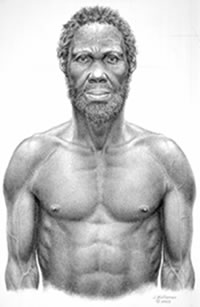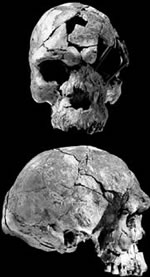Last week there were two items on bbc.co.uk and cbsnews.com that contained some speculations and comments arising from evolutionist prejudices.
In an article entitled “Itchy answer to hairless humans” that appeared on June 9, 2003, Oxford University professor Sir. Walter Bodmer and Reading University professor Mark Pagel put forward a new evolutionist idea that, unlike chimpanzees and other mammals, human beings were not covered with hair. Researchers have pointed out that a lot fewer parasites and fleas would live on skin without hair; they claimed that this nakedness was an advantage because the skin would have been more hygienic. According to this claim, as ape men scratched each other to get rid of fleas, their hair may have fallen out.
This evolutionist claim that appeared on bbc.co.uk is nothing more than a story with no scientific basis.
Actually, this kind of story that evolutionists frequently resort to in proposing their scenarios of human evolution are always products of the same system of ideas.
If we consider the three stages on which this system of ideas is based on, we see the fantasy that lies behind it. In the first stage, an already existing physical attribute is observed (in this example, skin without fur). In the second stage, the advantages of this attribute is examined (hygiene). In the third and final stage, it is proposed that the attribute whose advantages are shown has gone through a particular process of selection (nakedness is the result ape men scratching each other).
These evolution stories have no scientific value because it is impossible to go back in time and prove them. Moreover, there is no material proof to show that these stories are true. A story is just a story.
A particular characteristic of these evolution stories is that they create the problem of a supposition based on a supposition. At the root of human evolution scenarios is the supposition that human beings separated and evolved from an ancestor they had in common with the chimpanzee. (For a discussion of the invalidity of this supposition, see Harun Yahya’s Darwinism Refuted, Goodword, 2003). The story about the loss of hair proposed on bbc.co.uk is another invention based on the above supposition. So it appears that this item on bbc.co.uk is actually, from the scientific point of view, a story within a story.
Furthermore, this story is inconsistent with itself. Researchers have not yet been able to provide a logical explanation as to why parts of the human body are covered with hair. An other inconsistency is why the advantage of hairlessness has not been selected among chimpanzees or other mammals. Christophe Soligo, who researches human origins in the London Museum of Natural History alluding to this problem writes:
“The question we always have in explaining unique human traits is: why didn"t other animals evolve them as well if they are so advantageous?" 1
It can be seen that BBC in making these claims is only presenting ideas inconsistent with themselves and that have no basis in science but are founded on prejudice.
A second similar item appeared on CBS News on June 11, 2003 and was entitled “160,000-Year-Old Skulls Found”. This was an investigative report 2 that appeared in ‘Nature’ magazine which announced the discovery in Ethiopia of fossilized bones thought to belong to 10 individuals. Among the fossils determined to be 160 thousand years old, there were the complete skulls of an adult and a child as well as the partial skull of a third individual. The research team that found the fossils called them Homo Sapiens Idaltu. In the local Afar language, ‘’idaltu’ means ‘elder’. The only reason for this name is that they are the oldest examples of homo sapiens found in Africa. The skulls are large, with a round skull cavity and a flat face and there is no difference between them and modern human beings. Daniel Lieberman, a US anthropologist from Harvard University, have this explanation to Nature magazine’s news service:
“The bones have all the features of modern humans - there"s nothing lacking." 3
 Besides being potentially deceptive, reconstruction pictures, they can also reflect evolutionist ideas about skull. Here you see the skull in question and the reconstruction pictures that appeared on the cover of Nature magazine.
Besides being potentially deceptive, reconstruction pictures, they can also reflect evolutionist ideas about skull. Here you see the skull in question and the reconstruction pictures that appeared on the cover of Nature magazine.
It can be seen that the anatomy of the skull and information about its age show that it is no different from that of a modern human being and the picture indicates that this had been accepted by evolutionists.
Very well, let us consider how all this can be considered from an objective point of view.
On first consideration, what does the discovery of 160 thousand year old human skull that is no different from that of a modern human being say to a person? It says that the people who lived 160 thousand years ago in this area were like the people of today.
 But CBS News, given the impossibility that the skull can provide any information, simply makes this comment whose Darwinist prejudice is clear:
But CBS News, given the impossibility that the skull can provide any information, simply makes this comment whose Darwinist prejudice is clear:
“The …skull … appear[s] to represent a crucial stage of human evolution when the facial features of modern humans arose. Discovered in Ethiopia"s fossil-rich Afar region, the skulls have clearly modern features - a prominent forehead, flattened face and reduced brow - that contrast with older humans" projecting, heavy-browed skulls.”
These comments of CBS News with regard to evolution come only from prejudice. As we showed earlier, there is no difference between this skull and that of a modern human being. There is no difference that evolutionists can speculate about and no chance that they can be attributed to evolution. This is a basic case of ‘no evolution’. To think that a case of no evolution is a proof for evolution is an error that is hard to understand. Moreover, there have been a few discoveries that invalidate the prejudiced comments of CBS News. From its headlines, CBS News seems to believe that these skulls are those of the oldest human beings. However, many skulls have been discovered from Homo Erectus, Homo Heidelbergensis and Homo Sapiens Neanderthalensis who lived in much earlier periods. (For detailed information, see Harun Yahya’s Darwinism Refuted, Goodword, 2003)
The idea that Homo Sapiens Idaltu is the oldest human being comes from the fact that he reflects the average characteristics of modern human beings. Stages such as Homo Erectus and Homo Heidelbergensis are real human beings with variations seen in modern races of humans. Neanderthals, accepted by evolutionists as real human beings are an extinct European race. In short, Homo Sapiens Idalty cannot be accepted as the oldest human being.
The New York Times proposes a similar falsehood
The article by science writer John Noble Wilford in The New York Times entitled “Fossil Skulls Offer First Glimpse of Early Human Faces” (June 11, 2003) and the article in the International Herald Tribune entitled Skulls Lend Credibility to Out of Africa Theory (June 12, 2003) propose the same evolutionist falsehoods with regard to Homo Sapiens Idaltu.
As we stated above, there are many races of human beings that lived before Homo Sapiens Idaltu. Wilford writes that these fossils belong to a period in which human beings were developing from earlier creatures and offers the same erroneous information as that on CBS News. In fact, human history goes much farther back and to say that pre-Homo Sapiens Idaltu individuals were pre-human is only evolutionist prejudice.
Furthermore, Wilford claims that results obtained from genetic analysis supports the theory that modern human beings evolved in Africa and spread throughout the world. But if we separate this claim into two parts and examine each one we see that the part about evolution is based on prejudice. Genetic analysis can give some idea about the migration routes of human beings but the theory that they spread throughout the world from Africa does not prove that they came into being in Africa by evolution. The fact that human beings multiplied in a certain place and then spread throughout the world does not contradict that idea of creation and is not a proof for evolution.
There is no indication that Homo Sapiens Idaltu carries any traces of evolution; it is just one variation in the human genetic pool. All comments that go beyond this are prejudices that evolutionists put within their own system of ideas and cannot be proved.
Result
When considered in the light of scientific discoveries, it appears that the items on BBC and CBS News display a very wrong attitude. The common feature of their speculations and comments is the blind belief that human beings evolved from monkeys and that every discovery is evaluated according to this belief. These views communicated by BBC and CBS News are completely subjective and far from the objectivity that should be displayed by a media institution. Let us urge BBC and CBS News to abandon this wrong attitude.
However much they may want to ignore it, BBC and CBS News must realize that there are two views in the scientific world about the origins of human beings. The first is Darwinism that BBC and CBS News blindly takes every opportunity to support, and the other is creation. Modern science validates creation and invalidates Darwinism. Darwin’s mechanism (natural selection-mutation) has failed to explain the complexity of living things. The complex structures in living things can only be explained by deliberate design, that is, creation. Human beings did not come into being from monkeys, they were created. Almighty God reveals the creation in the Qur’an:
""We created humanity out of dried clay formed from fetid black mud."" (Qur’an, 15: 26)
1. “Early humans lost hair to beat bugs”, New Scientist, June 8, 2003: http://www.newscientist.com/news/news.jsp?id=ns99993807
2. White, T. D. et al. Pleistocene Homo sapiens from Middle Awash, Ethiopia. Nature, 423, 742 - 747, (2003) / Clark, J. D et al. Stratigraphic, chronological and behavioural contexts of Pleistocene Homo sapiens from Middle Awash, Ethiopia. Nature, 423, 747 - 751, (2003).
3. “Skulls reveal dawn of mankind”, Michael Hopkin, 11 June 2003:
http://www.nature.com/nsu/030609/030609-8.html


